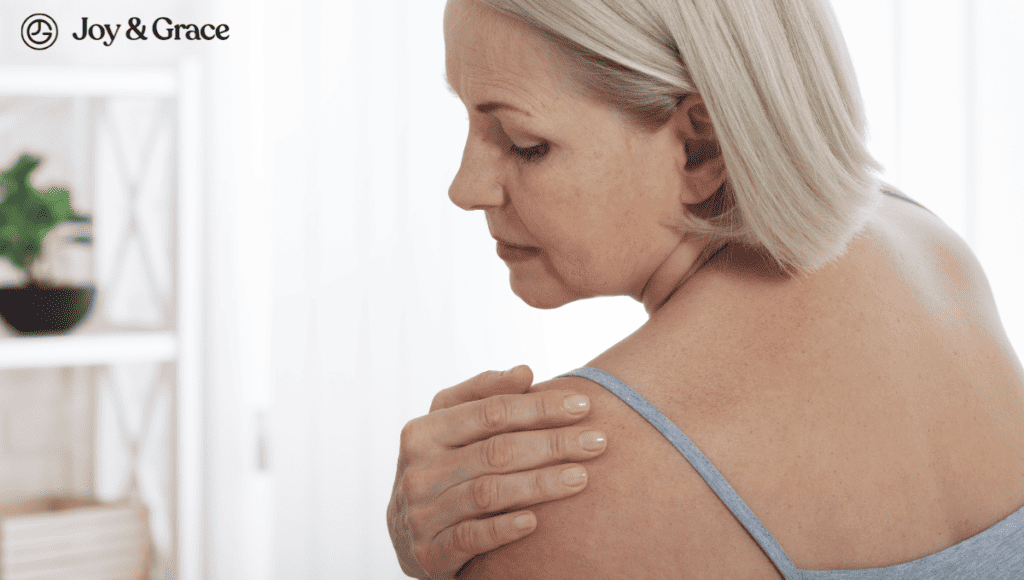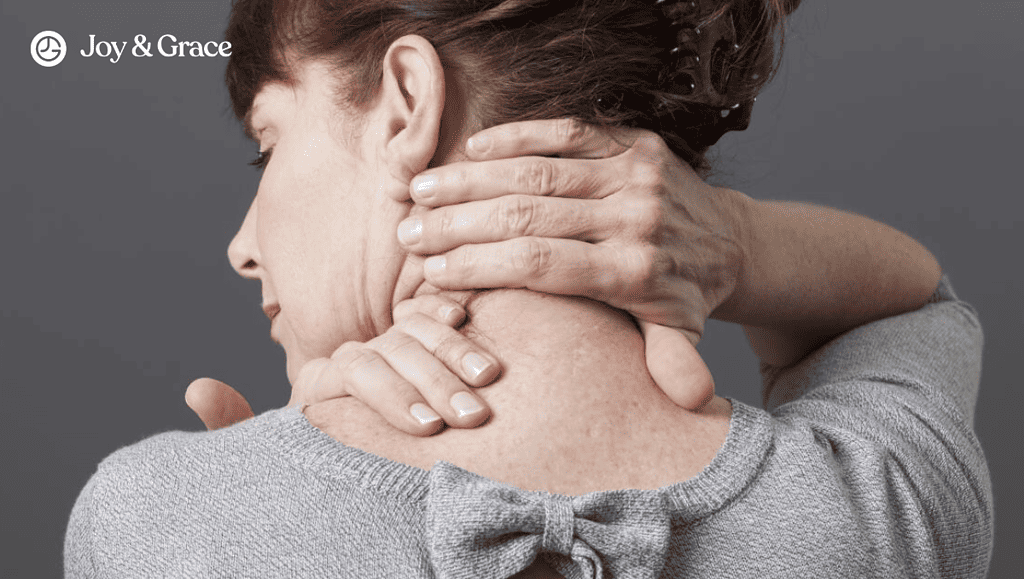Have you noticed your shoulder feeling painful, tender, or warm? Have you read about the possible connection between your pain and shoulder bursitis?
Shoulder bursitis is a painful inflammation of the shoulder bursa. This bursa is a small fluid-filled sac that cushions the shoulder joint structures.
Here, we elaborate on the most effective treatments to relieve bursitis pain in the shoulder. These treatments may be just what you need to get rid of your nagging discomfort for good.
What is the Best Treatment for Bursitis in the Shoulder?
The best treatment for bursitis in the shoulder depends on the type of bursitis. Generally, the best initial treatment for shoulder bursitis involves non-surgical methods. Surgery for bursitis is rarely necessary.
Shoulder bursitis is also known as subacromial bursitis. This is because of its position under the acromion (the top edge of your shoulder blade).
When faced with a bursitis case, doctors usually turn to the following treatments.
RICE (Rest, Ice, Compression, Elevation)

Apart from being a nutritious food, RICE is also an abbreviation. It means:
- Rest your shoulder joint. Don’t perform unnecessary movements or activities that may add to the bursitis pain.
- Ice your shoulder. Put an ice pack on your shoulder for 10–15 minutes. Place a thin towel between the ice pack and your skin. Do this once or twice every hour for three days.
- Compress your shoulder by gently wrapping it up with an elastic bandage. Compression can reduce swelling.
- Elevate your shoulder above the level of your heart while also applying ice. Use pillows if necessary. Elevation can also help with swelling.
Medications: What Medication Is Used for Shoulder Bursitis?
The right medicine for shoulder bursitis depends on what caused it. In most cases, medications that relieve pain and reduce inflammation are enough. These include painkillers. Topical medications or creams may also come in handy.
Since bursitis involves inflammation, properly dosed pain relief medication could essentially cure the condition, especially when combined with physical therapy.
In rarer cases, a more severe underlying cause may be the culprit of your bursitis. These cases call for more specific management and additional medications. One medical condition that doctors are especially careful about is bacterial infections. Bursitis caused by a bacterial infection requires the use of antibiotics. These are usually oral and can be taken at home as prescribed.
What is the Best Pain Reliever for Bursitis in the Shoulder?
Various oral painkillers and anti-inflammatory medications are available for bursitis in the shoulder. Tylenol (acetaminophen) and NSAIDs (non-steroidal anti-inflammatory drugs) are the best and most used ones. Examples of NSAIDs are aspirin, Advil (Ibuprofen), and Naproxene.
Painkillers work by interfering with inflammation pathways. Hence, they can reduce bursal inflammation and swelling and relieve shoulder pain.
Always take your pills as prescribed! Taking a higher-than-prescribed dose may damage your liver and stomach.
What Cream is Best for Shoulder Bursitis?
Topical creams on your skin can also work against bursitis pain in the shoulder. These may contain pain-relieving components like the NSAIDs we mentioned and capsaicin.
Capsaicin creams are derived from chili peppers. They can relieve shoulder bursitis pain by decreasing pain messages to the brain. On the other hand, creams with methyl salicylate (a cousin to aspirin) generate local cold followed by warmth. This effect can numb pain receptors, decreasing pain.
Why use NSAID creams instead of, let’s say, tablets? Topical NSAIDs are absorbed directly into the skin, bypassing your stomach entirely. This ability reduces the potential for stomach damage.
Make sure to follow your doctor’s advice when applying creams for bursitis.
Does A Steroid Injection Work for Shoulder Bursitis?
Corticosteroid injections can come into play if oral or topical medications don’t work. Corticosteroids are often given in the shoulder as a mixture with an anesthetic (pain-numbing solution). Ultrasound-guided cortisone injections may improve results.
Injections can provide quick pain relief. However, they may also cause a few side effects and weaken the muscle tendons.
By easing pain, they may also hide and delay the diagnosis of a possible underlying condition, such as a rotator cuff tear.
That's why doctors typically rule out a full rotator cuff tear first before considering injections for shoulder bursitis. Doing so helps ensure the right treatment approach for the specific condition.
In addition to pain relief, injections are sometimes also used as a diagnostic test. For instance, an initial injection into the subacromial bursa may cure bursitis, but it may only help partially or not at all with a partial rotator cuff tear or a frozen shoulder.
Physical Therapy and Exercise

Physical therapy and exercises are crucial in maintaining shoulder function in shoulder bursitis. A lack of physical therapy may result in atrophy (muscle wasting) and a frozen shoulder (joint tightening).
Physical therapy aims to relieve pain, avoid damage, and maintain rotator cuff tendon function. It involves different exercises that intend to:
- Improve shoulder and shoulder blade posture
- Improve the range of motion (ROM) of the shoulder
- Strengthen the shoulder muscles around the bursa
Here are some of the most effective exercises for shoulder bursitis:
- Table slides (Flexion)
Put a towel on a table and the heel of your hand on the towel. While sitting, slide your hand with the towel across the table and stretch. Repeat 20-30 times.
Stand upright with your back against a wall. Raise your arms to a 90-degree angle. Then, flex your elbows at a 90-degree angle. Your palms should be facing forward and your fingers upward. Raise your arms while extending your elbows as much as you can. Return to the starting position slowly. Repeat 10-12 times.
Sit on a chair and grab the base of the chair with one hand. Place the other hand on the opposite side of your head, arching above your head. Pull the side of your head toward your opposite shoulder. Keep your gaze in front of you and feel your trapezius stretching. Hold this position for 30 seconds. Repeat 1-3 times on each side.
Start by lying on your right side. Keep your right leg straight and your left leg flexed at the knee. Straighten your arm in front of you and keep your hands together. Slowly open your arms like you’d open a book page, reaching the back side of the floor with your left arm. Hold for 30-60 seconds. Repeat 1-3 times on each side.
For this exercise, you need a theraband. Attach the band to a door at chest-level height. While sitting or standing, pull the band toward you. While pulling, squeeze your shoulder blades together. Do 10-20 pulls.
Sit on a chair and keep your back and neck straight. Your legs should be touching the ground. Keep your arm straight on both sides. Gently push into the chair with your palms, then release and elevate your arms forward. Repeat 10-20 times.
Aspiration (Fluid Drainage)
Sometimes, the shoulder bursa may accumulate fluid and swell. Draining or aspirating this fluid with a syringe can provide relief in these cases. Moreover, the fluid can be tested for signs of infection or inflammation. This may help in the diagnosis of bursitis.
A corticosteroid injection may be given at the same time as an aspiration is performed.
Is It Good to Massage Shoulder Bursitis?
Massage therapy can be another effective method for relieving bursitis pain in the shoulder. It may work indirectly by increasing blood flow to the shoulder and relieving muscle tension.
Why do we say “indirectly”? Well, that’s because direct massage to the bursa may, in fact, worsen bursitis pain. Careful, gentle massages on and around your shoulder are the way to go. They can ease the stiffness and improve your mobility.
Surgery
Surgery is rarely needed to treat bursitis. It usually applies to chronic cases that have not improved with other treatments or have more complicated underlying causes.
The most common surgical treatment is an incision and drainage (I and D). This type of surgery is used only in cases of infected bursa. Other surgical methods may be needed when there's an associated muscle disorder, such as a rotator cuff tear.
What Should I Avoid With Shoulder Bursitis?

Shoulder bursitis can be a real hassle to deal with. To make your recovery easier, you must also understand what you need to avoid doing. We’ve got some tips.
First and foremost, avoid repetitive overhead activities. Gym workouts with overhead pressing or lifting can increase bursitis pain. Even light physical activities like painting ceilings or trimming trees can worsen the pain.
You must be extra careful if you’re about to lift something heavy. If you must work out, go easy on your shoulder. Limiting heavy work like moving furniture or carrying luggage can also benefit.
Avoid sleeping on the front or affected side at all costs! We’ll discuss the best way to sleep for bursitis below.
Avoid tobacco smoke, too. Smoking can delay tissue healing.
Avoid slouching. Poor posture can constantly pressure your shoulder joint, adding to the inflammation. Take frequent breaks and pay attention to your posture, even during work. Help yourself by turning to ergonomically designed chairs and furniture.
How Should I Sleep With Shoulder Bursitis?
If you have bursitis, simply switching to another side to sleep can do wonders. First, ensure your bed and pillows are comfortable. For shoulder bursitis, you can then:
- Sleep on your back. Place the affected arm across your stomach with your elbow flexed. Place a pillow underneath. The pillow lifts your arm and helps reduce the pressure on your shoulder.
- Sleep on your side. If you’re a side sleeper, lie on the opposite shoulder. Place one pillow in front of your chest and another on top so it goes under your affected arm. This position will raise your arm and reduce pressure on the shoulder joint.
What Are the Types of Shoulder Bursitis?
Based on its underlying cause, shoulder bursitis can be:
- Acute
- Infectious. Infectious bursitis comes from bacterial infections. It becomes especially dangerous if the bacteria manage to spread into the blood.
- Traumatic. Traumatic bursitis often happens after shoulder injuries. It’s common among athletes who tend to overuse their shoulders.
- Chronic
Chronic bursitis is the most common shoulder bursitis type. It occurs over time with repeated irritation of the bursa. Repeated bursal irritation can be seen in various disorders, like shoulder impingement syndrome.
What Are the Symptoms of Shoulder Bursitis?
Acute shoulder bursitis typically presents as pain or tenderness when touching your shoulder. You may feel aching or stiffness around the top and outer sides of the shoulder.
Other symptoms may include:
- Difficulty sleeping, especially when lying on the affected shoulder
- Swelling or warmth around your shoulder
- A reduced range of motion (ROM) of the shoulder
- Pain when lifting or pushing
On the other hand, chronic bursitis may be completely painless. In chronic bursitis, the skin around the shoulder can be red, warm, or damaged (from prior trauma).
How Long Does It Take for Shoulder Bursitis to Heal?
Let’s begin the ending of the article with some good news. In most cases, non-infectious shoulder bursitis heals on its own for a few weeks. Supportive treatment ensures recovery is complete. In cases of infectious bursitis, healing may take longer.
The outcomes for most patients with bursitis are good.
Takeaway
The best treatment for bursitis in the shoulder depends on the bursitis type. The best initial approach for shoulder bursitis involves conservative treatments.
Shoulder bursitis is also known as subacromial bursitis.
The best and most effective treatments for shoulder bursitis include the following:
- RICE (Rest, Ice, Compression, Elevation)
- Tylenol (acetaminophen) and NSAIDs (non-steroidal anti-inflammatory drugs)
- Antibiotics (in bacterial bursitis) or other additional drugs (in cases of underlying diseases)
- Topical creams that contain NSAIDs or capsaicin
- Corticosteroid injections (if oral or topical medications don’t work)
- Physical therapy and exercises
A lack of physical therapy may result in atrophy and a frozen shoulder.
- Draining or aspirating this fluid with a syringe can sometimes provide relief.
- Massage therapy
Surgery is rarely needed to treat bursitis. It applies to chronic pain cases that have not improved with other treatments.
If you’re suffering from shoulder bursitis, you should avoid:
- Repetitive movements, especially overhead activities
- Lifting heavy
- Sleeping on the front or affected side
- Tobacco smoke
- Slouching and ignoring your posture
Acute shoulder bursitis typically presents as pain or tenderness when touching the shoulder. Chronic bursitis may be completely painless.
In most cases, non-infectious shoulder bursitis heals on its own for a few weeks. Supportive treatment ensures recovery is complete.
In cases of infectious bursitis, healing may take longer.















